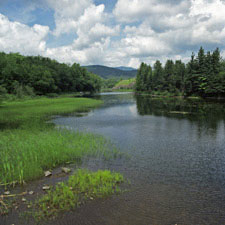Time to register for MVFN’s Thursday, May 20 Spring Gathering banquet and lecture—May 20, 2010. Tickets must be purchased in advance by May 14. See details at end of articleAdirondack Park Comes to Lanark County!
by Cathy Keddy

Where is North America’s nearest and largest protected landscape? Perhaps the Everglades, or maybe Yellowstone National Park? No, not even close. They are much too small and distant. In fact, North America’s largest protected landscape is only a few hours drive from Lanark County. Not Algonquin Park, although at roughly 3 times the size of Lanark County it is indeed large and significant. However, it isn’t nearly as big as the Adirondacks, in the opposite direction, and just south across the St. Lawrence River in northern New York.
Double the size of Algonquin, the Adirondacks are easily eight times the size of all of Lanark County. Very big and near—just over the horizon, a vast reservoir of plants and animals already adapted to our northern climate. In fact, the Adirondacks are so close that many birds could spend the night in the Adirondack forests, and drop in the next day to visit us. The wood thrushes, rose- breasted grosbeaks and yellow-rumped warblers are already making their way north to Lanark County, and may right now be planning their last night of rest in the Adirondacks before dropping in to breed in our forests. Some may also carry seeds from their last meal to deposit here. It is entirely possible, therefore, that the Adirondacks and Lanark County are biologically linked. Did the beech trees of Lanark County spread slowly north after the ice age, or did they simply drop out of the sky as seeds in the crops of passenger pigeons? Yes, there are old records of passenger pigeons nesting south of Carleton Place, and beech seeds were one of their favoured foods. Of course, hunters exterminated passenger pigeons, so they are no longer carrying tree seeds north. But other birds may be taking up some of the slack.
A truly remarkable aspect of the Adirondacks is its similarities to Lanark County, and Algonquin Park. It is a large dome of hard rock, mostly gneiss and granite, of the same age and chemical composition as the rocks that underlie much of our county. Consequently, it is the headwaters for rivers. The forests have northern tree species like white pine, red oak, sugar maple, and hemlock. (Indeed, if you were dropped by helicopter on the shore of a small lake, you might not know whether you were in Algonquin, the Adirondacks, or northern Lanark County.) Even the bird calls and frog calls would be the same.
Early in its history, the Adirondacks experienced the same impacts as Lanark County. The area was logged and mined. Wildlife was trapped for felt hats, forests were harvested for potash bound for Europe and charcoal was exported for iron ore. Hemlock trees were stripped for tanning leather. By the mid 1800s, the wild landscape was beginning to show the negative impacts of human exploitation. Then, remarkably, in 1892, in what was then a cutting-edge environmental decision, the state of New York decreed that the forests of the Adirondacks would remain “forever wild.” Although much of the landscape had already been altered, the remainder, perhaps some 200,000 acres, remained intact, leaving one of the largest stands of old growth forest in eastern North America. So, if you want to see what Lanark County looked like in the really old days, drive south into New York State. Saranac Lake is accessible by highway, but some of the hills around it have never been cut. In contrast Algonquin was so heavily logged that old growth is rare.
Of course, not everyone has the time to drive to the Adirondacks, so the Mississippi Valley Field Naturalists have gone one better. They are bringing the Adirondacks to Lanark County with Dr. Jerry Jenkins, a well known biologist who has spent 40 years exploring the park. Jenkins, Forest Issues Coordinator for the Wildlife Conservation Society, will speak at MVFN’s Spring Gathering 2010 being held May 20 in Carleton Place. Enjoy a banquet dinner beginning at 6 pm, and following the banquet, let Dr. Jenkins be your guide to the delights of the Adirondacks and their lessons for the future of Lanark County.
Spring Gathering 2010 will take place Thursday, May 20 at the Carleton Place Curling Club, 102 Patterson Crescent. Tickets ($20), which include a reception and banquet, are available by contacting Brenda Boyd (613-256-2706) in Almonte. Tickets must be purchased in advance by Friday May 14. They can also be purchased at Read’s Book Shop in Carleton Place or the Nature Lover’s Bookshop in Lanark. Or send a cheque to MVFN, Box 1617, Almonte, ON K0A 1A0 (must be received by Friday May 14), and your tickets can be picked up at the event.







